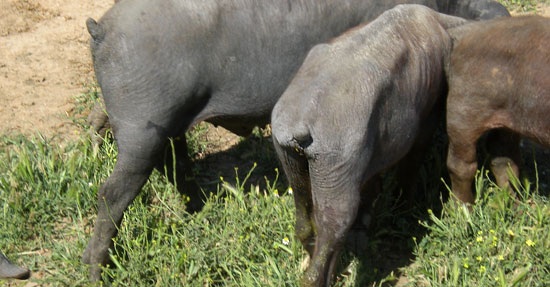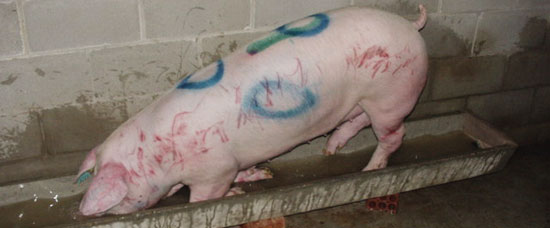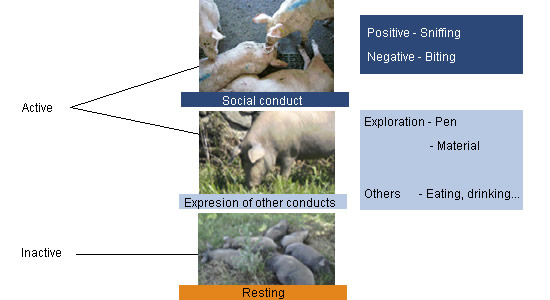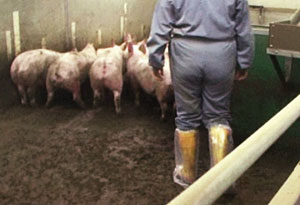1. Feeding
This principle includes an absence of prolonged hunger or thirst. For the first criteria, body condition is evaluated through visual inspection as well as palpation of the hip bones and the spine (Fig. 1). For the second criteria the number of drinkers is considered, as well as functionality and cleanliness.

2. Housing
In this principle there are three criteria to keep in mind. The first of those is comfort of rest which is evaluated based on the presence of bursitis (inflammation of the joints) in the limbs and the presence of stool in the body. Animals resting on a hard and abrasive surface causes them to develop bursitis, classified by number, dimensions and state (the presence of necrosis, open rounds, etc). The presence of stool in the body indicates that the animals sleep in dirty areas, which means their level of comfort during this time is affected.
The second criterion is an adequate effective temperature. Stress due to cold is evaluated based on the presence of shivering animals, or animals huddling together. Stress die to heat is measured by the presence of panting animals.
The third criterion is ease of movement, and it is measured based on the availability of space in the distinct areas used by the pigs (density, farrowing cages, etc).
3. Health
The first criteria of this principle refers to the absence of lesions, whether due to rounds produced by fighting or hitting (Fig. 2), lesions due to biting of tails or vulvas, and limping. The protocol only evaluates severe limping (when the animal cannot support itself on one limb) or extremely severe limping (when the animal cannot get up at all).

The second criterion is the absence of illness. Animals are evaluated for respiratory problems (cough, sneezing, atrophic rhinitis), digestive problems (diarrhea, prolapsed rectum, constipation), reproductive problems (mastitis, prolapsed uterus), splay leg in piglets, skin conditions (generalized inflammation, burns, mange), abscesses and the presence of inguinal or umbilical hernias that make movement difficult for the animals, as well as signs of necrosis.
The third criteria is the absence of pain induced through handling, gestation, sacrifice, or surgical intervention (for example, castration or tail docking), and the criteria for euthanasia, the handling of sick animals, cleaning and disinfection routine as well as the castration and .tail docking practices, are evaluated.
4. Behaviour
The first criterion to consider is that the pigs can demonstrate behavioural characteristics specific to their species, such as their social and exploratory conduct (rooting). For the evaluation, repeated observations of the animals are carried out and they distinguish, in the first place, 2 types; inactive animals (laying down and sleeping) and active animals (Fig. 3). The active animals are classified by those who have social conduct, exploratory conduct or other conducts. Within those with social conducts there is a distinction made between positive (sniffing, licking) and negative (biting, displacing others, and fights). Within the exploratory conduct, distinctions are made between the exploration o fan area (any point in the corral except for troughs) and the exploration of enrichment materials. In pregnant sows the presence of stereotypies, which is considered to be abnormal behaviour.

The second criterion is the man-animal relationship. When the observer enters the corral, the animal may react by ignoring him, moving away from him, moving towards him to sniff or trying to escape with panicky behaviour (Fig. 4). This last one is the only one of the four possibilities that is evaluated negatively in the protocol. A fearful pig may suffer more stress when faced with any handling by humans, be it in maternity or while being loaded onto a truck.

Lastly, the third criterion evaluates the emotional state of the animals based on a qualitative behavioural conduct test in different areas of the farm. This test is used to compile information about how the animals conduct themselves and interact with other animals and within their environment.
The Welfare Quality® project has edited a book detailing the different measures and their evaluation methodology (www.welfarequality.net). There is an existing protocol for fattening pigs and another for sows and piglets.




